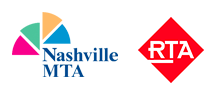WPLN
Tony Gonzalez
Nashville’s transit future could include entirely new routes, high-tech intersections, and even a rail system, according to a new study by the Metro Transit Authority that’s part of the ongoing nMotion 2015 planning process. Yet the agency won’t make changes to the system before being sure that people will actually use it — prompting a pair of public meetings this week.
Among the MTA’s latest ideas are several meant to improve existing service, making bus pickups more frequent across the county and allowing buses to move faster throughout downtown.
How fast?
MTA CEO Steve Bland said the agency has long used every-30-minutes as a standard, but the public tends to see every 10 minutes as the standard.
“Until we can start getting into that category where essentially you can throw the schedule away and just expect something to be coming along, we’re going to be hard-pressed to really attract large numbers,” Bland said.
His agency’s latest report suggests allowing buses to move through traffic faster — especially through downtown Nashville. That could mean special lanes, or traffic lights that bus drivers control.
These tweaks to the system would be a first step.
But the MTA could also expand into so-called “premium” transit — like light rail, streetcars, or bus rapid transit, such as The Amp. That big idea drew scorn and fell apart.
So this time, Bland says, he wants to balance urgency with finding a plan that the public supports.
“We get people’s up-front ideas about what it will take to get them to use the system, not for every trip, but what trips will they use it for?” Bland said.
The agency will share and test strategies and various alternatives in the coming months.
The latest strategy document was published in full online. The public gets its first shot to talk about it at 5 p.m. Tuesday at the East Park Community Center. There’s a second meeting Wednesday at 11:30 a.m. at the downtown Nashville Public Library.
The MTA is also exploring whether to run buses later into the night and how to better connect the system with neighboring counties.
A redesign of the entire downtown transit flow is also possible.
A final action plan is due early next year, with other reports on downtown, the region and bus rapid transit to arrive before anything is finalized.
“People are spending more time away from their families and away from work in traffic,” Bland said. “And so despite the fact that we’ve added services, we’ve improved services, we’ve improved performance, those issues keep getting bigger and bigger.”

Please don’t give up on light rail. The kind of “premium transit” draws riders. Look at the success of light rail in Dallas as an example.